Table of Contents
- Editor’s Choice
- Global Chatbot Market Size Statistics
- Chatbot Statistics by Usage in Industries
- Chatbot Statistics by Major Sectors with Sites
- Top Countries Adopting Chatbot Statistics
- Chatbot Consumer Demographics
- Chatbot Statistics by User Engagement
- Chatbot Statistics by User Preferences
- Chatbot Statistics by eCommerce
- Chatbots for Retail and Customer Support
- Chatbot Statistics by Benefits
- Chatbot Statistics by Challenges in Adoption
- Recent Developments
- Conclusion
- FAQs
Chatbot Statistics: A chatbot is a computer program designed to simulate human conversation, utilizing Natural Language Processing (NLP) technology. To understand and respond to user input naturally and contextually relevantly.
Versatile, accessible on various platforms, and available 24/7, making them valuable for customer support, information retrieval, and task automation.
Chatbots offer scalability, data-driven insights, customization to match a brand’s tone, and seamless integration with existing systems.
Evolution is driven by artificial intelligence and machine learning advancements, enabling them to understand user intent and adapt over time.
Chatbots have become indispensable tools for businesses aiming to enhance customer engagement, streamline processes, and deliver personalized user experiences. With their potential applications continually expanding in the digital landscape.
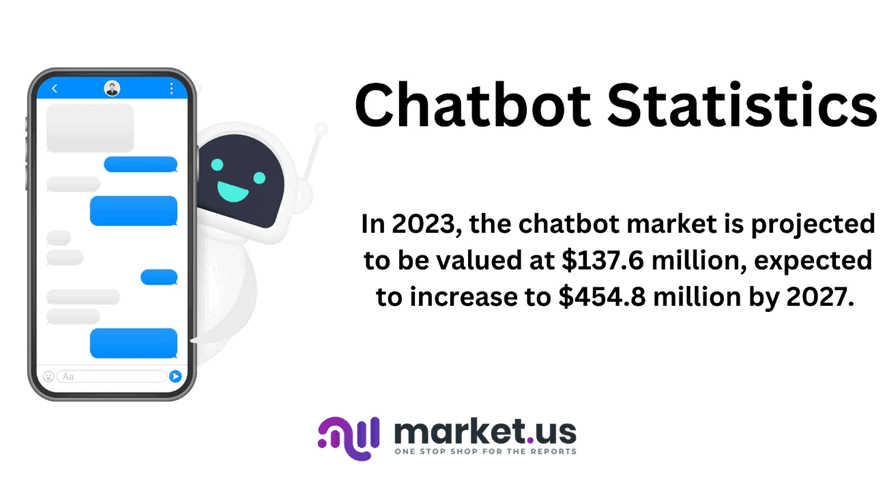
Editor’s Choice
- In 2023, the chatbot market is projected to be valued at $137.6 million, expected to increase to $454.8 million by 2027.
- Businesses can save a substantial 2.5 billion hours by employing chatbots for customer support
- On average, customer support representatives handle approximately 17 daily interactions.
- Chatbots are capable of handling around 70% of these interactions efficiently.
- 74% of customers prefer chatbots over human corporate agents when seeking solutions to their queries.
- With an impressive growth rate of 24.9%, chatbots stand out as the fastest-growing brand communication medium.
- In 2023, it’s anticipated that chatbots will address up to 90% of healthcare and financial inquiries, reflecting their increasing role.
- The E-commerce industry is experiencing growth through the integration of chatbots. While only 9% of customers believe businesses should avoid adopting them.
- Furthermore, Facebook Messenger alone boasts a staggering user base of over 3 million active chatbots, highlighting their widespread adoption.
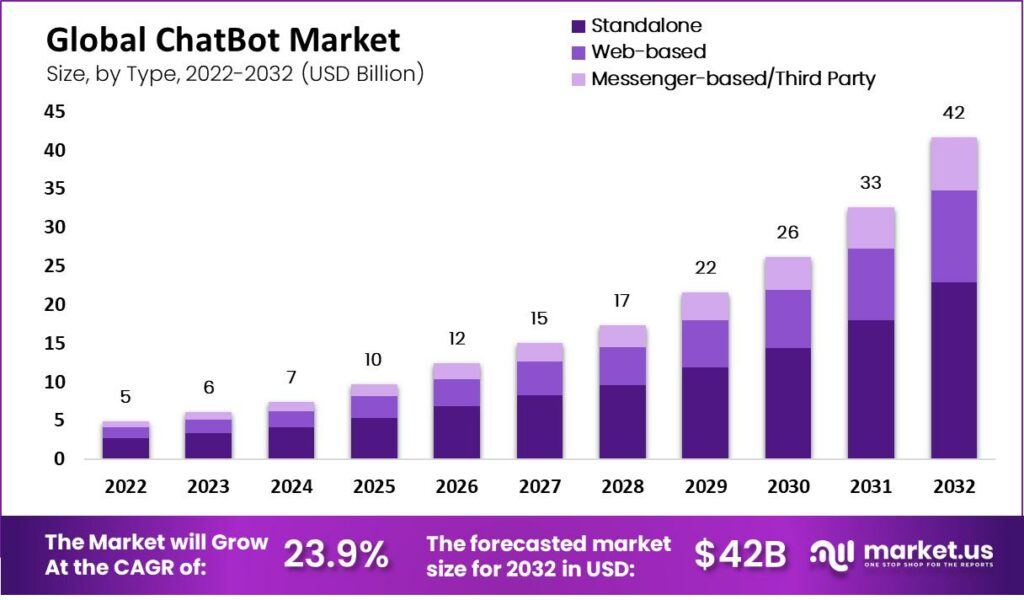
Global Chatbot Market Size Statistics
- The revenue generated by chatbots has exhibited remarkable growth over the past decade.
- In 2018, chatbot revenue stood at 40.9 million dollars, which experienced a steady ascent over the subsequent years.
- By 2019, it had risen to 51.7 million, followed by 65.5 million in 2020.
- The year 2021 marked a significant leap, with revenue reaching 83.4 million.
- The revenue figures for 2022, 2023, and 2024 climbed to 106.6 million, 137.6 million, and 179.9 million, respectively.
- The substantial growth, with revenue projected to reach 239.2 Mn in 2025, 325.3 Mn in 2026, and a substantial 454.8 million by 2027.
- This remarkable trajectory underscores chatbots’ increasing importance and adoption across various sectors. Reflects their potential to revolutionize customer service, streamline business processes, and provide valuable insights into user interactions.
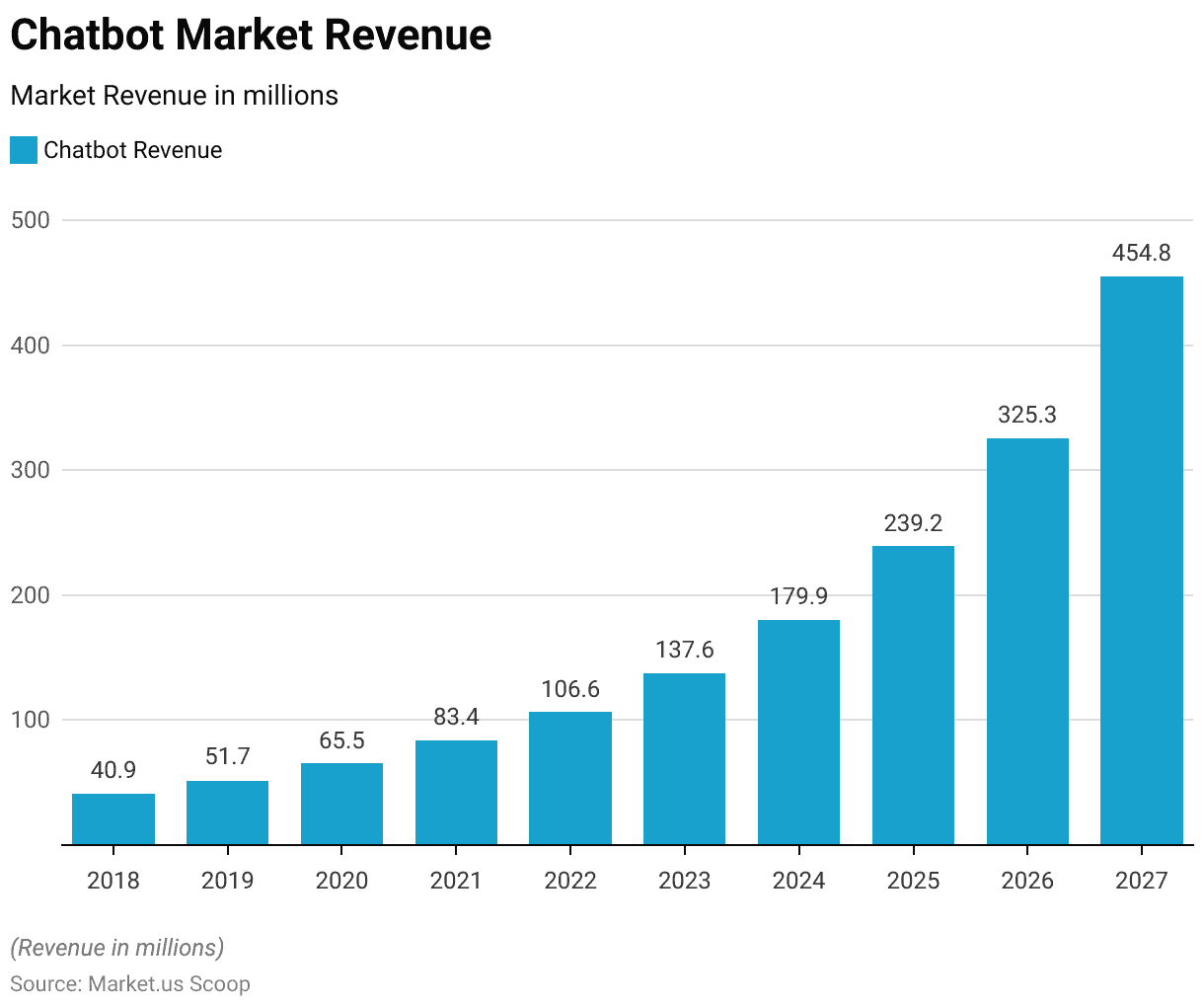
Chatbot Statistics by Usage in Industries
- Chatbots are increasingly finding their place across various industries, each sector adopting them to varying degrees.
- Chatbot usage in education is 14%, demonstrating their potential to assist with student inquiries and streamline administrative processes.
- On the other hand, real estate has embraced chatbots even more. With a usage rate of 28%, which aids in property inquiries and customer interactions.
- The travel industry benefits from chatbots at a rate of 16%, enhancing the booking experience and providing travel-related information.
- Healthcare, a sector where data privacy and accuracy are crucial, employs chatbots at a 10% adoption rate. Helping with patient inquiries and appointment scheduling.
- In the finance sector, chatbots are utilized to a lesser extent, with a 5% usage rate, assisting with financial queries.
- These varying adoption rates reflect the diverse applications and readiness of different industries to leverage. The potential of chatbot technology for improved customer service and operational efficiency.
(Source: Chatbots Life)
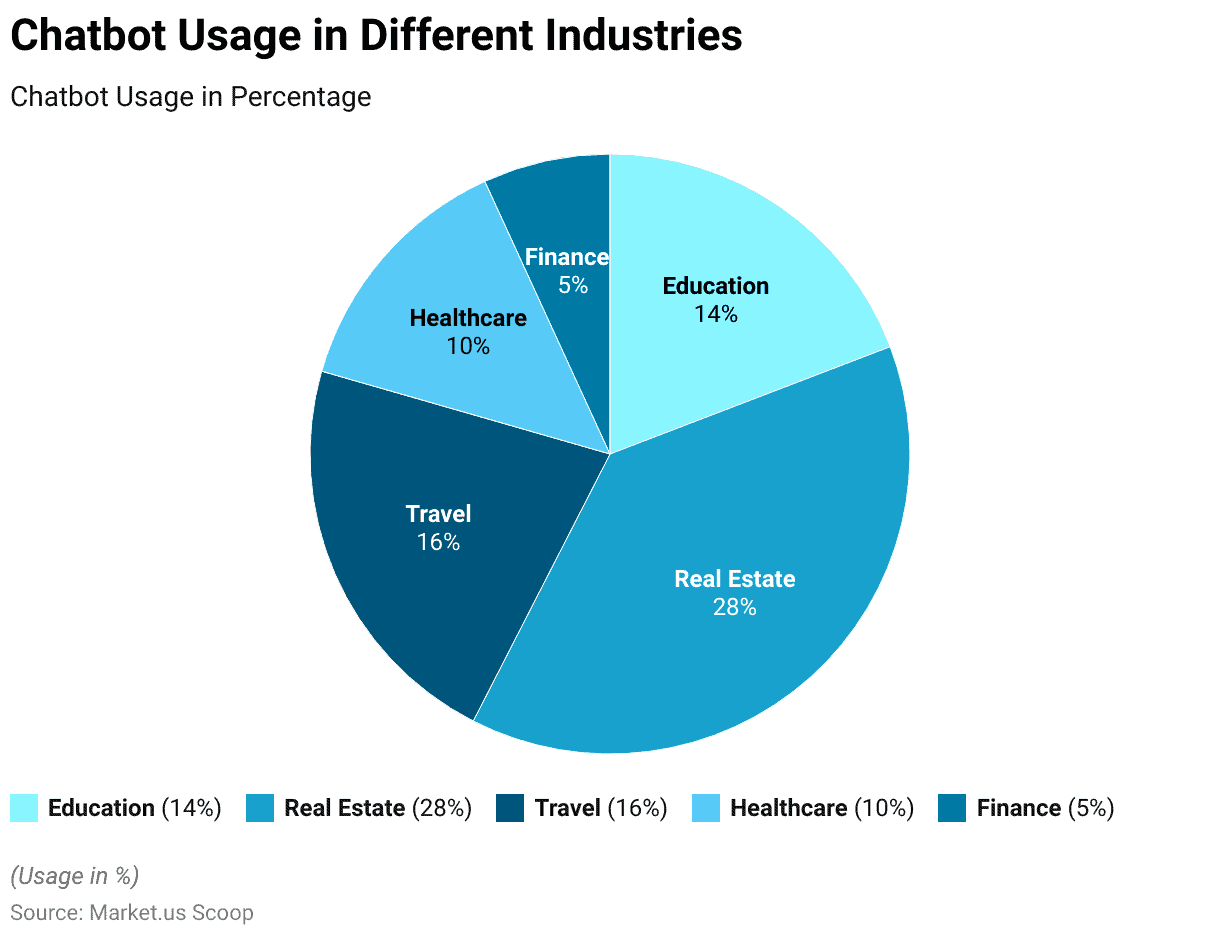
Chatbot Statistics by Major Sectors with Sites
- Chatbots have found significant adoption across various sectors, with a notable presence in the Internet software sector, accounting for 65.1% of chatbot sites.
- Professional services follow with 8.4%, showcasing their utilization in enhancing client interactions and support within this industry.
- Healthcare stands at 6.6%, reflecting their role in streamlining patient engagement and inquiries.
- Chatbots contribute to 3.9% of the industry’s sites in the consumer discretionary sector, while media and consumer staples register at 2.7% and 1.9%, respectively.
- Even in the hotels and leisure sector, chatbots have made their mark, representing 1.7% of chatbot sites.
- This data underscores the diverse applications of chatbots, spanning across industries to enhance customer experiences, streamline operations, and provide efficient support.
(Source: Boomtown)
Take advantage of our unbeatable offer - buy now!

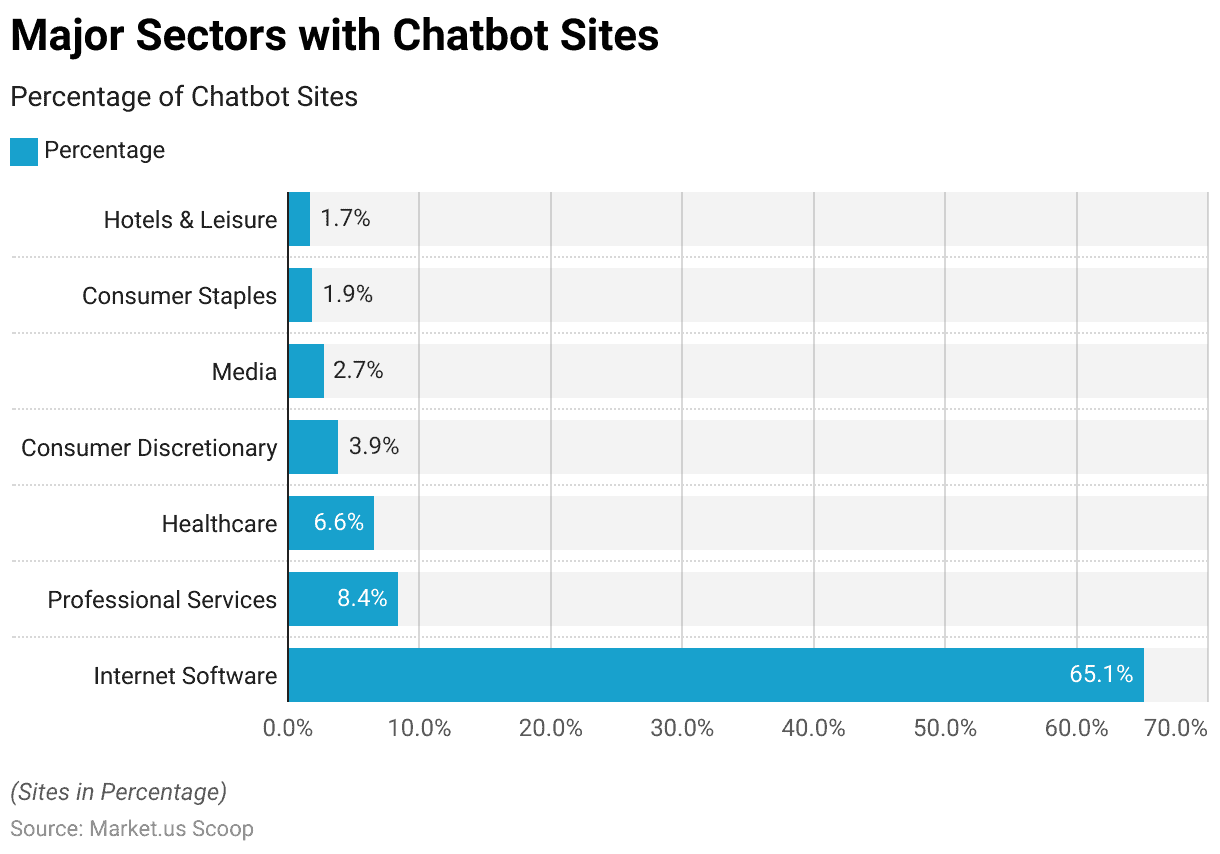
Top Countries Adopting Chatbot Statistics
- Chatbot adoption rates vary significantly across different countries, reflecting the diverse landscapes of technological integration.
- In the United States, chatbot adoption stands at a robust 36%, showcasing a high acceptance and utilization of chatbots for various applications.
- India follows with an 11% adoption rate, demonstrating a growing interest in chatbot technology.
- In Germany, chatbots have a 4% adoption rate, indicating a moderate usage level within the country.
- The United Kingdom and Brazil exhibit relatively lower adoption rates, with 3% and 2%, respectively, suggesting a slower pace of chatbot integration in these regions.
- These country-specific adoption rates highlight the varying degrees of readiness and enthusiasm for incorporating chatbots into business operations and customer interactions across the globe.
(Source: Chatbots Life)
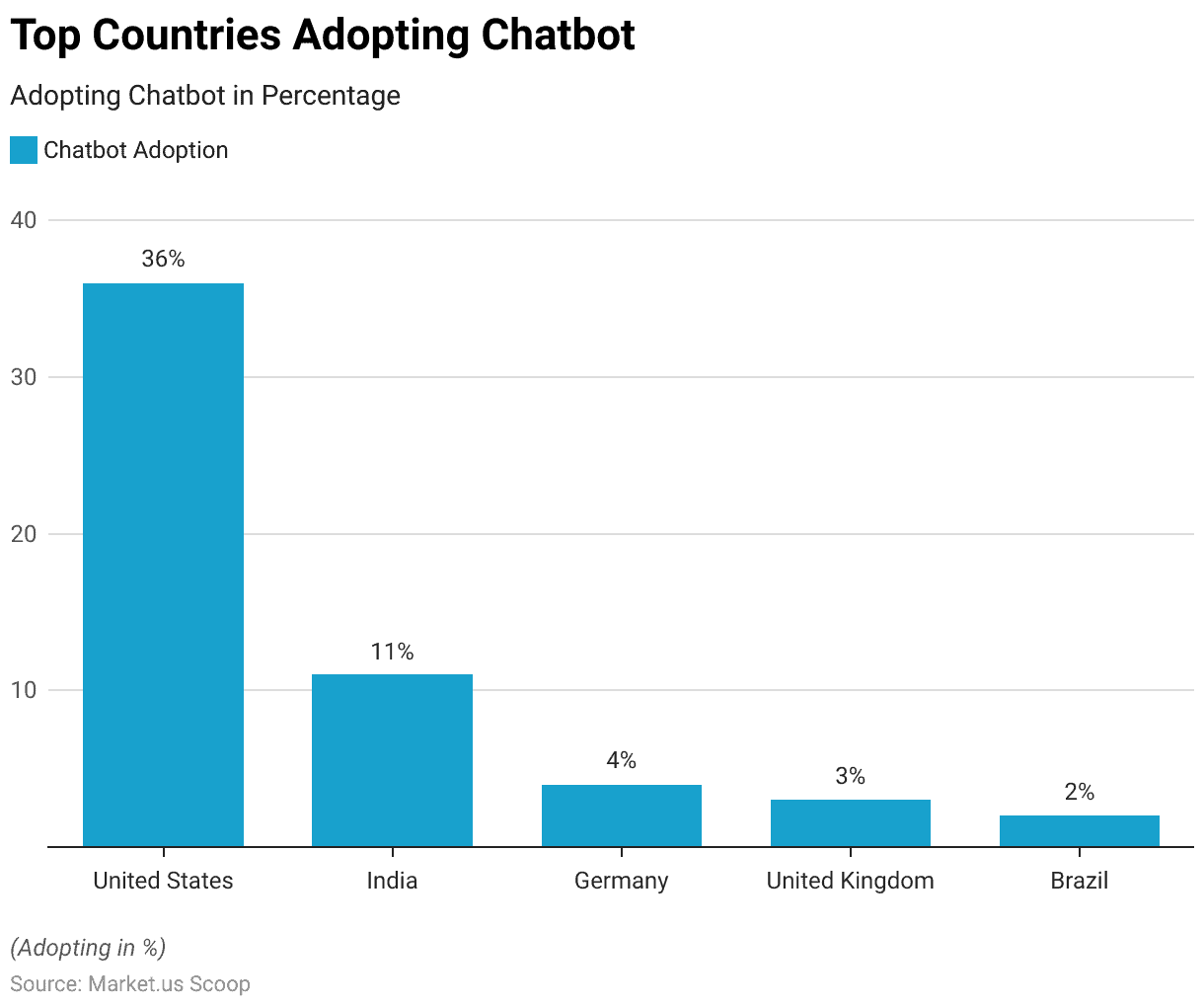
Number of Websites with a Chatbot- by Country
- In examining the prevalence of chatbots across various countries, it becomes evident that the United States leads the pack with 15,515 chatbot sites, reflecting a density of 0.0477 chatbots per 1,000 people in a population of 325 million.
- Australia, with 1,009 chatbot sites and a population of 24 million, closely follows at 0.042 chatbots per 1,000 people.
- The United Kingdom and the Netherlands demonstrate similar trends, with 2,667 and 684 chatbot sites, respectively, and chatbot densities of 0.041 and 0.0402 per 1,000 people.
- Canada and France also show notable chatbot adoption, with 1,265 and 569 sites, resulting in 0.0351 and 0.086 chatbots per 1,000 people, respectively.
- Meanwhile, Germany, Brazil, and India exhibit varying levels of chatbot integration, with Germany having 0.058 chatbots per 1,000 people, Brazil at 0.0019, and India at 0.0005, highlighting the diverse landscape of chatbot usage globally.
(Source: Boomtown)
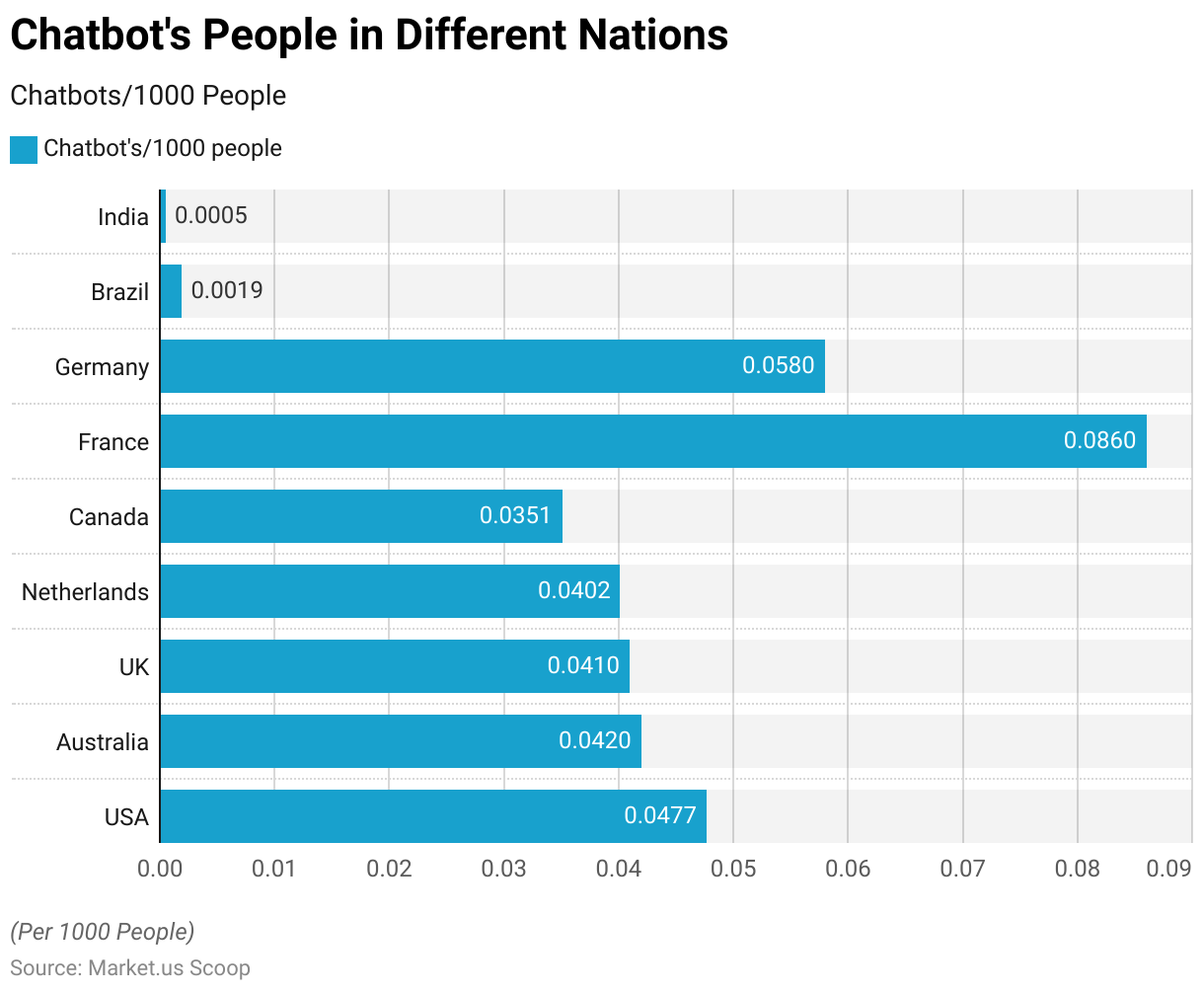
Chatbot Consumer Demographics
- A significant 40% of individuals from the millennial generation interact with bots every day.
- Regarding purchasing products or services, 67% of millennial internet users in the US express their to buy from brands employing chatbots.
- Notably, 66% of millennials prioritize 24-hour availability as the most valuable aspect of chatbots, compared to 58% of Baby Boomers who share this perspective.
- Impressively, 70% of millennials have positive experiences with chatbots.
- Among consumers aged 35-44 in the United States, a notable 60% feel that companies are overly eager to substitute human representatives with chatbots.
(Source: Mobile Marketer, Drift, Forbes, CGS)
Chatbot Statistics by User Engagement
- Approximately 1.4 billion people actively use messaging apps and are open to interacting with chatbots.
- The top anticipated use case for chatbots is obtaining quick assistance during emergencies, followed closely by resolving issues or inquiries.
- A notable 35% of individuals turn to chatbots to address complaints or obtain in-depth information.
- In the business landscape, 58% of B2B companies incorporate chatbots into their websites, surpassing the 42% adoption rate on B2C websites.
- Notably, 40% of millennials engage with bots daily.
- Response rates for chatbots vary, with lower-engagement ones achieving 35-40%, while more user-friendly bots can achieve impressive 80-90% response rates.
- Chatbots have experienced a substantial 92% increase in usage since 2019, marking them the fastest-growing brand communication channel.
- Users are increasingly open to engaging with chatbots for various purposes, such as making purchases, scheduling meetings, and signing up for mailing lists, with usage rates more than doubling from 2019 to 2020.
- Additionally, 46% of companies utilizing intelligent assistants or AI chatbots employ them for voice-to-text transcription services.
- IT departments are the primary beneficiaries of chatbot support in businesses, accounting for 53% of organizations.
- Impressively, 87.2% of consumers rate their typical chatbot interactions as neutral to positive, highlighting the generally favorable reception of these automated conversational agents.
(Source: Acquire, Relay, Mobile Marketer, Drift, Matthew Barby, Spiceworks)
Chatbot Statistics by User Preferences
- Only a small fraction, a mere 9% of consumers, believe businesses should completely abstain from using chatbots.
- According to research conducted by NewVoiceMedia, almost half of consumers, precisely 46%, perceive chatbots as tools intended to dissuade them from seeking assistance from live human representatives.
- A significant majority of 60% of consumers prefer human agents, believing that humans possess superior capabilities in comprehending their requirements compared to chatbots.
- Strikingly, even when confronted with wait times, 60% of individuals still lean towards waiting for a human agent instead of engaging with a chatbot.
- Most, precisely 48%, prioritize a chatbot’s proficiency in resolving issues over its personality.
- In a Usabilla survey, 46% of respondents voiced their inclination to interact with a live person, even if using a chatbot could save them 10 minutes.
- Among consumers aged 35-44, 60% feel companies are overly eager to substitute human representatives with chatbots.
- However, a more adaptable 40% of consumers have no strong preference between engaging with a chatbot or a human as long as they receive effective assistance for their needs.
(Source: Userlike, NewVoiceMedia, Business Insider, Userlike, Usabilla, CGS, HubSpot)
Chatbot Statistics by eCommerce
- As reported by Chatbot Magazine, a study uncovered that incorporating chatbots to send personalized messages to customers who abandoned their online shopping carts could potentially boost revenue by up to 15%.
- Invesp’s research revealed that, when it comes to eCommerce, 34% of individuals prefer chatbots over other service-oriented settings, even including scenarios like banks where AI bots assist customers.
- Kindly’s survey noted a substantial 30% increase in order tracking when eCommerce stores employed chatbots, enhancing the overall user experience during the product purchase process.
- Kahoot, a popular online game, reported that over 2 billion players utilized chatbots to seek assistance during gameplay and received prompt and direct responses.
- In a separate analysis, Juniper Research estimated that the eCommerce market could potentially achieve sales of $112 billion by employing chatbots for various functions and notifications.
(Source: Chatbot Magazine, Invesp, Kindly, Kahoot, Juniper Research)
Chatbots for Retail and Customer Support
- Approximately two-thirds, or 67%, of consumers globally engaged with chatbots for customer support within the past year.
- The primary concerns people encounter when utilizing chatbots for their customer service inquiries revolve around two main issues: a lack of clarity in understanding the problem or the chatbot’s limitations in resolving complex issues.
- As reported by IBM, businesses stand to benefit significantly from chatbots, with potential cost savings of up to 30% in customer support.
- A notable 27% of consumers were uncertain whether their last customer support interaction involved a human or a chatbot.
- In retail, 34% of customers expressed comfort in conversing with AI chatbots for customer service instead of live human representatives.
- The majority of businesses, specifically 64%, believe that chatbots have the potential to enhance customer support by providing a more tailored experience.
- Consumers identify “24-hour service” as the primary advantage of having chatbots available for their online services.
(Source: Invesp, NewVoiceMedia, IBM, PwC, Statista, Drift)
Chatbot Statistics by Benefits
- According to business leaders, chatbots have, on average, boosted sales by a substantial 67%.
- A significant 57% of businesses have reported that chatbots yield significant returns on investment with minimal financial outlay.
- Nearly 90% of those surveyed have observed tangible enhancements in the speed of resolving customer complaints, and more than 80% have seen improved efficiency in processing call volumes through AI.
- An impressive 80% of respondents have noticed measurable improvements in customer satisfaction, service quality, and the overall performance of their contact centers.
- For 64% of businesses, chatbots are expected to enable the delivery of more personalized customer support experiences.
- The automation of chatbots has the potential to result in savings of up to $23 billion annually in salary expenses.
- Consumers and businesses will collectively save over 2.5 billion hours in customer service interactions by 2023.
- These efficiencies are estimated to translate to a cost reduction of $0.70 per customer interaction.
(Source: Forbes, Accenture Digital, MIT Technology Review, Statista, BusinessInsider, Juniper Research, CNBC)
Chatbot Statistics by Challenges in Adoption
- As per findings from the Accenture Digital Chatbot Report, companies that are hesitant to embrace chatbots have cited several reasons for their reluctance.
- The concern, voiced by 64% of respondents, is user adoption hesitancy, reflecting a reluctance among users to engage with conversational bots.
- Subpar performance is another major issue, with 51% expressing dissatisfaction
- Due to the bot’s inability to incorporate historical context for personalized interactions.
- Additionally, 47% of respondents noted subpar performance as chatbots struggled to comprehend human input fully.
- Concerns about navigating new privacy, security, legal, and regulatory considerations were raised by 45% of participants, while 44% indicated a shortage of skilled developers as a limiting factor.
- Conversely, certain challenges have arisen or are anticipated for those favoring chatbot implementation.
- The most prominent challenge, identified by 65%, is the scarcity of skilled talent available for bot development and management.
- Deployment costs were a concern for 49%, followed closely by the expense of acquisition or purchase at 46%.
- Data privacy and security ranked high, with 42% expressing apprehensions and the desire for bots to possess self-learning and self-aware capabilities, which also garnered a 42% response rate.
(Source: Accenture Digital Chatbot Report)
Recent Developments
Acquisitions and Mergers:
- Zendesk acquires Cleverly: In late 2023, Zendesk acquired Cleverly, a startup specializing in AI-driven customer support automation, for $180 million. This acquisition aims to enhance Zendesk’s chatbot capabilities by integrating Cleverly’s advanced AI technology into its customer service platform.
- IBM acquires WDG Automation: IBM completed its acquisition of WDG Automation, a robotic process automation (RPA) and chatbot technology company, in early 2024 for $200 million. This merger is expected to strengthen IBM’s AI-powered automation solutions.
New Product Launches:
- Microsoft Azure Bot Service Updates: In mid-2023, Microsoft introduced significant updates to its Azure Bot Service, including improved natural language understanding (NLU) and integration with Microsoft Teams, enhancing the development and deployment of sophisticated chatbots.
- Google Dialogflow CX: Google launched Dialogflow CX in late 2023, a new advanced version of its chatbot development platform designed for complex, multi-turn conversations, offering better scalability and integration with Google Cloud services.
Funding:
- Intercom raises $125 million: Intercom, a leading provider of customer messaging platforms, secured $125 million in a funding round in 2023 to expand its AI and machine learning capabilities for chatbot development and enhance its global market presence.
- ManyChat secures $50 million: In early 2024, ManyChat, a chatbot platform for marketing and sales automation, raised $50 million to accelerate its product development and scale its operations internationally.
Technological Advancements:
- AI and Machine Learning Integration: Chatbots are increasingly integrating AI in machine learning to provide more accurate and context-aware responses, improving user interactions and automating complex customer service tasks.
- Multilingual Capabilities: Advances in natural language processing (NLP) are enabling chatbots to support multiple languages more effectively, broadening their accessibility and usability across different regions and markets.
Market Dynamics:
- Growth in Chatbot Market: The global chatbot market is projected to grow at a CAGR of 23% from 2023 to 2028, driven by increasing demand for automated customer support and the growing adoption of AI technologies in various industries.
- Rising Adoption in Healthcare: Chatbots are seeing increased adoption in the healthcare sector for applications such as patient engagement, appointment scheduling, and telemedicine, providing efficient and scalable solutions for healthcare providers.
Regulatory and Strategic Developments:
- Data Privacy Regulations: As chatbots handle sensitive customer data, compliance with data privacy regulations like GDPR and CCPA is becoming crucial. Companies are enhancing their chatbot platforms to ensure data security and regulatory compliance.
- Industry Standards: Efforts are being made to establish industry standards for chatbot development and deployment to ensure consistency, security, and interoperability across different platforms and applications.
Research and Development:
- Emotionally Intelligent Chatbots: R&D efforts are focusing on developing emotionally intelligent chatbots that can understand and respond to user emotions, providing more personalized and empathetic interactions.
- Voice-Enabled Chatbots: Researchers are advancing voice-enabled chatbot technology to offer more natural and conversational experiences, integrating voice recognition and synthesis capabilities to enhance user engagement.
Conclusion
Chatbot Statistics: They emerged as invaluable tools for businesses and organizations in the ever-evolving digital communication and customer service landscape. Chatbots generate a wealth of data, from engagement metrics to user feedback.
Organizations that harness this data effectively gain a competitive advantage by making informed decisions to improve their chatbot’s effectiveness. The success of a chatbot is closely tied to the user experience it provides.
Chatbots find utility across various industries, from customer support and e-commerce to healthcare and finance.
Understanding each sector’s unique requirements and challenges is crucial for successful implementation. Looking to the future, chatbots will continue to play a pivotal role.
Advancements in AI and (NLP) will open new possibilities, and the ethical and regulatory landscape will evolve alongside.
FAQs
A chatbot is a computer program designed to simulate human conversation. It can interact with users via text or voice. It is often used to answer questions, provide information, or assist with tasks.
Chatbots use natural language processing (NLP) and machine learning algorithms to understand and respond to user inputs. They analyze text or speech inputs and generate relevant responses based on pre-defined rules or learned patterns.
Chatbots are used in various industries and applications, including customer service, e-commerce, healthcare, finance, etc. They can be found on websites, messaging apps, and voice-activated devices.
There are two primary types of chatbots: rule-based chatbots and AI-powered chatbots. Rule-based chatbots follow predefined scripts, while AI-powered chatbots use machine learning to improve their responses over time.
Chatbots can provide 24/7 customer support, reduce response times, handle repetitive tasks, improve user experiences, and help businesses save time and resources.
Discuss your needs with our analyst
Please share your requirements with more details so our analyst can check if they can solve your problem(s)



